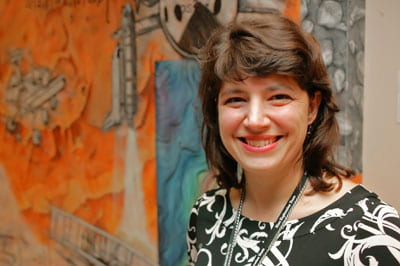Monitoring Mars: With successful rover landing, Yingst’s work has just begun
 Due to the successful and historic landing of the Mars rover Curiosity Monday, UW-Green Bay’s Aileen Yingst will be away for a while.
Due to the successful and historic landing of the Mars rover Curiosity Monday, UW-Green Bay’s Aileen Yingst will be away for a while.
About 90 Martian days, in fact.
Yingst, director of the Wisconsin Space Grant Consortium, headquartered at UW-Green Bay, is the deputy principal investigator for the Curiosity mission’s Mars Hand Lens Imager (MAHLI) camera, an instrument so powerful it can return images of individual grains of sand on the planet’s surface. She watched the rover land from mission headquarters early Monday (Aug. 6), joining in a jubilant celebration with “about 400 of my best friends” at the Jet Propulsion Laboratory (JPL) in Pasadena, Calif.
Reached by cell phone midday Monday, Yingst was preparing to obtain the first color image from the surface, having grabbed a few hours sleep before what’s likely to be a late night. She expects to be in Pasadena into November, returning home from her NASA-funded position permanently after 90 Martian days — each day on Mars is about 37 minutes longer than a day here.
“We’re living on Mars time,” Yingst said. “I keep trying to remind myself that this is a marathon, not a sprint.”
One can, of course, forgive the enthusiasm of Yingst and her colleagues, who are part of what’s been called the Apollo 11 of the unmanned space program. The unprecedented rover landing was so complex it was dubbed the “seven minutes of terror,” a highly coordinated and precise maneuver during which the Mars Science Laboratory spacecraft carrying Curiosity decelerated from about 13,200 mph (about 5,900 meters per second) to allow the rover to land on the surface at about 1.7 mph (three-fourths of a meter per second).
And the landing lived up to its name.
“It was terrifying,” Yingst said. “All the scientists were kind of put into the basement of one of the JPL buildings, in part so we could all experience it together. It was awesome. It was exactly as they billed it — it was terrifying, in part, not because we distrusted the engineers … but Mars can throw you a curveball, and there’s nothing you can do about that.”
The unpredictable nature of space is something Yingst knows all too well, having been part of a not-so-successful mission years ago. She was working as a postdoctoral fellow at the University of Arizona when the Mars Polar Lander crashed on Dec. 3, 1999. A picture of a dejected-looking Yingst ended up on the front page of the L.A. Times, making the frustration of the mission failure even more inescapable.
“So this is a pretty righteous moment, I’ve got to admit,” she said. “I can’t take credit for it, but it’s still sweet.”
What Yingst can take credit for is the work of her instrument, the MAHLI, which will return pictures of the Martian surface at 12 microns/pixel (for comparison, a human hair is about 80 microns across). At this scale, Yingst said, the surfaces of individual minerals, or even sand grains, can be seen. The MAHLI camera will be critical in determining what rocks are made of at the Mars Science Laboratory landing site, where Yingst and her colleagues expect the rocks will be sedimentary (broken up bits of other rocks, transported there by wind, water or volcanic activity).
There’s a lot of pressure, but also a lot of excitement for the instrument’s potential.
“(This is a) priceless resource from the surface, and we want to use it well,” Yingst said. “There will be rich rewards if we do this right.”
And while Yingst’s work will take her away from home and family for a while, her husband and kids — 9-year-old Josh and 8-year-old Rebecca — are having a wonderful time witnessing history in Pasadena. They attended a landing event at the California Institute of Technology, attached to the Jet Propulsion Laboratory, communicating via text message about what was going on. A phone call placed once the rover had landed quickly was ended, as neither party could hear over the jubilant roar of assembled scientists. Yingst will come home for such milestones as the first day of school, but for now, her home base is Pasadena.
And while few got to experience the historic rover landing the way Yingst did, the moment truly belongs to everyone, she said.
“When the first images came down, and I realized we were looking at a place in the universe that no human being had ever seen, there’s a moment of elation there,” she said. “That comes from not only having worked so hard at this, but realizing I was seeing this at the same time as everyone else in the world. … That shared moment was made possible because of the technology that we have derived from the space program.
“I don’t know any other way of putting how beautifully this has come full circle. I think everybody back home should be tremendously proud of this moment, because it belongs to everybody.”
Click the links for more on the Curiosity mission and Yingst’s role therein.


